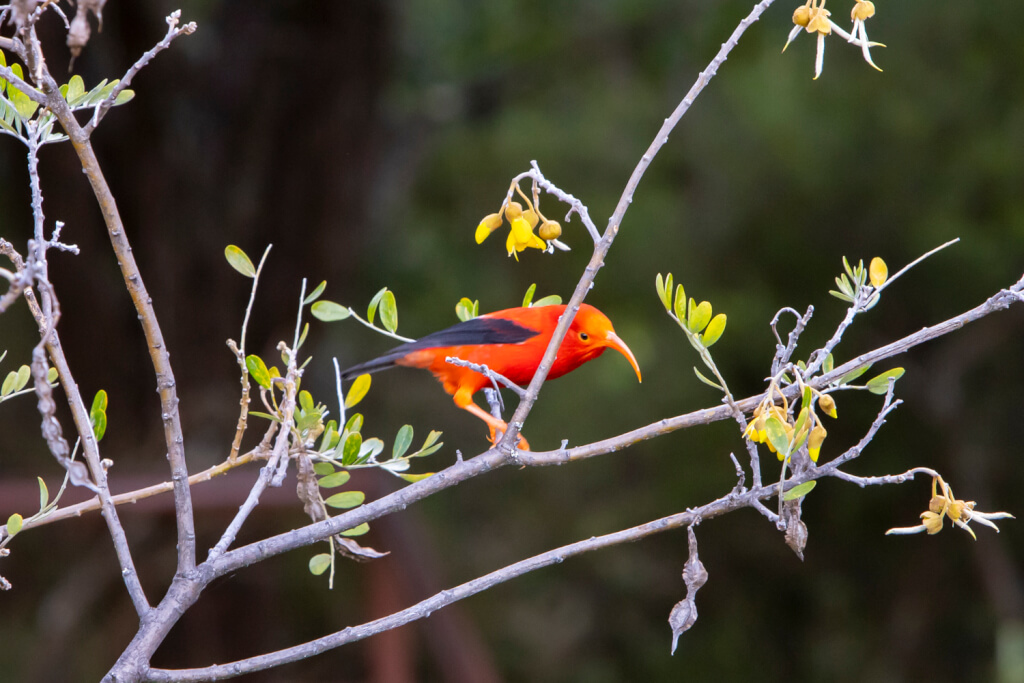Happy day! A plan to save Hawaiian Honeycreepers is approved by the National Park Service and State Board of Land and Natural Resources! This innovative, non-invasive plan should significantly boost our critically endangered manus’ fight for survival, even though some sought to block it.
It’s no secret that Hawaii is the extinction capital of the world. Over 90 species of endemic birds have vanished, along with over 80 species of insects and at least one species of bat. Some of these extinctions occurred just in the past few years, as was the case with George the Tree Snail, who died on January 1, 2019. And more species are on the verge of extinction. Just look at our native birds.
Six are likely extinct, having last been observed nearly 40 years ago, and several will likely become extinct in the next couple of years if something isn’t done now. The most vulnerable is likely the Kiwiku, which currently exists only on Maui, and has an estimated population of less than 150.

Plan to Save Hawaiian Honeycreepers is Approved
Given the dire situation surrounding the Kiwiku, and even the ‘Akohekohe, immediate action is desperately needed. Earlier attempts to relocate birds to establish new populations have failed, with nearly all relocated Kiwiku succumbing to avian malaria. That, by the way, is a problem that continues to worsen, as rising temperatures are allowing mosquitoes to travel further up slope, invading the Kiwiku’s and ‘Akohekohe’s last remaining refuge. That’s why it has become critically important to find a way to control mosquito populations in the area and why it’s so important that a plan to save Hawaiian Honeycreepers is approved.
This specific plan to save Hawaiian Honeycreepers involves breeding millions of male mosquitos, infecting them with specific Wolbachia bacteria, and releasing them into the wild. This bacteria, which naturally occurs in mosquitos, makes it so that populations with one strain cannot breed with a population with another strain. That will effectively diminish mosquito populations in treated areas.
With approvals now in hand, officials plan on beginning execution in just a few months. At the moment, that will result in Federal, State, and private conservation teams releasing millions of mosquitos per year across 65,000 acres of National Park, state, and private lands, and 1,400 proposed release locations. Releases will be conducted via drone and helicopters in summer and fall, which is typically when mosquito populations peak in Hawaii.
Opposition to Plan to Save Hawaiian Honeycreepers
A plan to reduce the number of mosquitos in critical habitats using naturally occurring bacteria that already occur in the bugs in nature sounds like a no-brainer, right? Unfortunately, not so. Some people in Hawaii got the idea that these mosquitos are genetically modified and began strongly opposing the effort. Others became fearful that the plan would somehow create negative impacts for people.
Both of these fears are completely untrue. As I said earlier, the process involves taking standard mosquitos, infecting them with a type of bacteria that already naturally occurs in them, and releasing them into the wild.
Further, while I can understand the concern for human impacts, this process has actually been used for about 50 years now. In fact, Wolbachia mosquito control was developed to benefit humans and has been successfully used in places like California, Florida, Kentucky, and New York, all with zero human impacts.
Of course, just a few minutes of research or reading would’ve prevented a lot of this misinformation. It makes me sad that people can be swayed so easily by misinformation and don’t take a brief moment to learn for themselves. But such is society these days.
Final Thoughts
This plan to save Hawaiian Honeycreepers has been on the table for a long time now, and I’m glad it’s finally going to happen. The hope is that it’ll result in a 90% reduction in mosquito populations in these areas, which is, quite literally, the only hope we have left for saving the Kiwiku and ‘Akohekohe. Yup, while we now have approvals, the work to save these critically endangered birds is only just beginning. I just hope it works and allows Kiwiku and ‘Akohekohe to not only survive but thrive. In fact, it’s my hope that I can one day see ‘Akohekohe somewhere easy to access, like Hosmer Grove.
